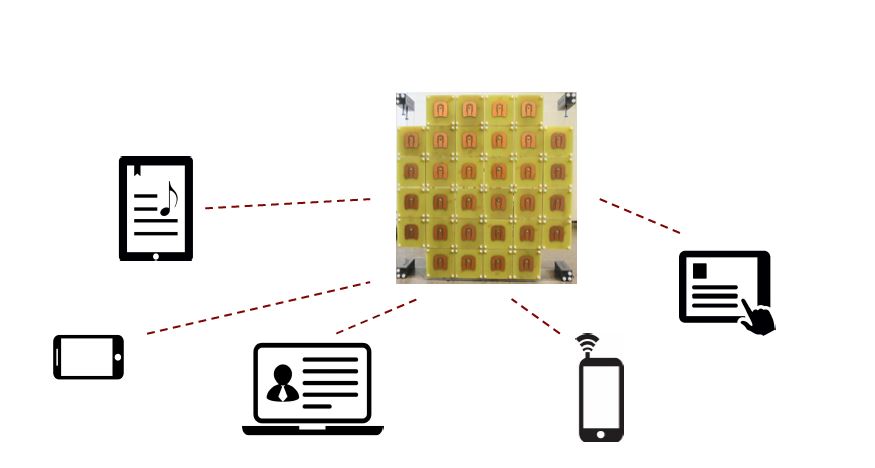Massive MIMO for 5G
By Erik G. Larsson, Linköping University, Linköping, Sweden and Liesbet Van der Perre, KU Leuven, Leuven, Belgium
IEEE 5G Tech Focus: Volume 1, Number 1, March 2017
1. What is Massive MIMO?
Massive MIMO is the currently most compelling sub-6 GHz physical-layer technology for future wireless access. The main concept is to use large antenna arrays at base stations to simultaneously serve many autonomous terminals, as illustrated in Figure 1. The rich and unique propagation signatures of the terminals are exploited with smart processing at the array to achieve superior capacity. Massive MIMO splendidly offers two most desirable benefits:
- Excellent spectral efficiency, achieved by spatial multiplexing of many terminals in the same time-frequency resource. Efficient multiplexing requires channels to different terminals to be sufficiently different, which has been shown to hold, theoretically and experimentally, in diverse propagation environments. Specifically, it is known that Massive MIMO works as well in line-of-sight as in rich scattering [1,Chapter 7].
- Superior energy efficiency, by virtue of the array gain, that permits a reduction of radiated power. Moreover, the ability to achieve excellent performance while operating with low-accuracy signals and linear processing further enables
considerable savings.
Figure 1: Massive MIMO exploits large antenna arrays to spatially multiplex many terminals.
The key technological characteristics of Massive MIMO are:
- Fully digital processing; each antenna has its own RF and digital baseband chain. Signals from all antennas at each base station are processed coherently together. Core advantages of fully digital processing include the avoidance of specific assumptions on propagation channel, the possibility to measure the complete channel response on the uplink and respond fast to changes in the channel. Interestingly, recent assessments show that the full digital processing may not only offer superior performance but also better energy efficiency [2], a trend which may be reinforced by the ongoing development of tailored low-power circuits.
- The reliance on reciprocity of propagation and TDD operation, enabling downlink channels to be estimated from uplink pilots, and obviating the need for prior or structural knowledge of the propagation channel.
- Computationally inexpensive precoding/decoding algorithms, taking the form of maximum-ratio (known also as conjugate beamforming) or zero-forcing processing. Massive MIMO functions equally well with single-carrier transmission and OFDM.
Notably, conjugate beamforming with OFDM is equivalent to time-reversal in a single-carrier system. - Array gain, resulting, in principle, in a closed-loop link budget enhancement proportional to the number of base station antennas.
- Channel hardening, that effectively removes the effects of fast fading. Operationally, each terminal-base station link becomes a scalar channel whose gain stabilizes to a deterministic and frequency-independent constant. This greatly simplifies resource allocation problems.
- The provision of uniformly good quality of service to all terminals in a cell -- facilitated by the link budget improvement offered by the array gain, and the interference suppression capability offered by the spatial resolution of the array. Typical baseline power control algorithms achieve max-min fairness among the terminals.
- Autonomous operation of the base stations, with no sharing of payload data or channel state information with other cells, and no requirements of accurate time synchronization.
- The possibility to reduce accuracy and resolution of transceiver frontends, and the digital processing and number representations in computations.
The attractive properties of propagation -- penetration of solid objects and diffractive behavior -- and the maturity of hardware renders Massive MIMO primarily a below-6 GHz technology for radio access. This is also the region where spectrum is most valuable. Arrays have attractive form factors even for large numbers of antennas: in the 3.5 GHz TDD band, a half-wavelength-spaced rectangular array with 200 dual-polarized elements is about 0.6 x 0.3 meters large; in practice, larger antenna spacing may be desired and is easily afforded. However, systems operating at higher frequencies up to millimeter-waves may also benefit from the application of Massive MIMO, especially when these systems would need to support multi-user access in potentially non-Line-of-Sight scenarios.
2. What is Massive MIMO not?
Various large antenna systems are investigated and deployed in the quest for higher capacity and robust wireless access solutions. "Full dimension", "3D beamforming", and "grid-ofbeams" concepts, that rely on FDD operation or even hybrid beamforming, are sometimes marketed as Massive MIMO. Such solutions are less scalable with respect to the number of antennas, and importantly, they rely on specific properties of propagation or user location that limit their application to a substantial extent.
Point-to-point MIMO solutions with large arrays at the transmitter and/or receiver also are not Massive MIMO: Massive MIMO truly entails multiuser MIMO, relying on channel state information obtained through measurements on uplink pilots. Versions that operate in FDD and rely on the transmission of downlink pilots followed by subsequent fast CSI reporting by the terminals are also possible, but only in scenarios with relatively low mobility and small numbers of base station antennas.
3. Why is Massive MIMO Becoming a Reality Right Now?
Since its inception about a decade ago, the Massive MIMO concept has evolved from a wild "academic" idea to one of the hottest research topics in the wireless communications community, as well as a main work item in 5G standardization.
The time for Massive MIMO has come at this moment for two reasons: First, conventional technology has proven unable to deliver the spectral efficiencies that 5G applications are calling for. Second, the confidence in the exceptional value of the technology has spread rapidly since impressive real-life prototypes showed record spectral efficiencies, and the robust operation with low-complexity RF and baseband circuits has been substantiated [3].
4. What are the Operational Limits of Massive MIMO?
Massive MIMO is scalable with respect to antennas; additional antennas always help. The ultimate limit is dictated by mobility: every coherence interval (coherence time multiplied by coherence bandwidth) needs to accommodate uplink pilots, and payload in the uplink and downlink directions. The higher mobility, the less channel coherence and the fewer pilots can be afforded. In high-mobility macro-cellular environments (highway), this limits the multiplexing gain to some dozen of terminals but in environments with less or no mobility, hundreds or even thousands of terminals could in principle be multiplexed. The number of antennas that ultimately prove useful scales similarly, and are likely to be limited to one or a few hundred in macro-cellular, but potentially thousands in low-mobility applications [4].
5. Will Massive MIMO Work in Practice?
Massive MIMO does work in practice! It has been demonstrated to achieve a record spectral efficiency of 145 bps/Hz in a real-life testbed experiment with 100 antennas at the base station. This demonstration does show an improvement of more than 20 times over 4G systems, yet was achieved in a controlled lab environment. Adding more antennas to the base station and deploying more dedicated hardware could support more simultaneous users. Efficient operation has been validated in a wide range of propagation conditions including indoor and outdoor situations. The solutions to compensate for non-reciprocity of front-ends in TDD-based channel estimation have been confirmed to be robust. Recently the proof was extended to true mobile access: communication with pedestrians and cars can be maintained. These experiments show that channels can be tracked sufficiently fast to spatially multiplex moving users [4].
In parallel, hardware implementations have been progressed very favorably. Fore mostly, it has been technically proven that Massive MIMO systems can be built with very low complexity hardware, both for the digital baseband and the analog RF chains. Moreover, innovative architectures and circuits that exploit the specific nature of Massive MIMO systems are being designed. These will further reduce power and cost and promote an attractive deployment of Massive MIMO systems [8].
6. What Could Massive MIMO Offer More in the Future?
Massive MIMO can offer enhanced broadband services in the future, and more. 5G networks are expected to support a great variety of wireless services in areas ranging from infotainment to healthcare, smart homes and cities, manufacturing, and many others. Massive MIMO technology can be tailored to support a massive number of Massive Machine Type Communication (MTC) devices. Also, it is an excellent candidate to realize Ultra Reliable Communication as it can establish very robust physical links.
References
- T. Marzetta, E. G. Larsson, H. Yang and H. Q. Ngo, Fundamentals of Massive MIMO, Cambridge University Press, 2016.
- Buzzi, S., D’Andrea, C., “Are mmWave Low-Complexity Beamforming Structures Energy-Efficient? Analysis of the Downlink MU-MIMO.”, IEEE Globecom workshops 2016, Washington D.C. USA, December 2016
- Prabhu, H., Rodrigues, J., Liu, L., Edfors, O. “A 60 pJ/b 300 Mb/s 128× 8 Massive MIMO Precoder-Detector in 28 nm FD-SOI.” International Solid-State Circuits Conference (ISSCC), San Francisco (CA) USA, February 2017
- Massive MIMO: News - commentary - mythbusting, www.massive-mimo.net
- A. Nordrum. (2016, May). “5G researchers set new world record for spectrum efficiency,” IEEE Spectr., [Online]. Available: http://spectrum.ieee.org/techtalk/telecom/wireless/5gresearchers- achieve-new-spectrum-efficiency-record
- Larsson, E. G., Edfors, O., Tufvesson, F., & Marzetta, T. L. (2014). Massive MIMO for next generation wireless systems. IEEE Communications Magazine, 52(2), 186-195.
- Björnson, Emil, Erik G. Larsson, and Thomas L. Marzetta. "Massive MIMO: Ten myths and one critical question." IEEE Communications Magazine 54.2 (2016): 114-123.
- FP7-MAMMOET European project, www.mammoet-project.eu
 Erik G. Larsson (This email address is being protected from spambots. You need JavaScript enabled to view it.) is Professor at Linköping University, Sweden, and Fellow of the IEEE. He co-authored the textbook Fundamentals of Massive MIMO (Cambridge University Press, 2016). He received the IEEE Signal Processing Magazine Best Column Award twice, in 2012 and 2014, and the IEEE ComSoc Stephen O. Rice Prize in 2015.
Erik G. Larsson (This email address is being protected from spambots. You need JavaScript enabled to view it.) is Professor at Linköping University, Sweden, and Fellow of the IEEE. He co-authored the textbook Fundamentals of Massive MIMO (Cambridge University Press, 2016). He received the IEEE Signal Processing Magazine Best Column Award twice, in 2012 and 2014, and the IEEE ComSoc Stephen O. Rice Prize in 2015.
 Liesbet Van der Perre (This email address is being protected from spambots. You need JavaScript enabled to view it.) is Professor at KU Leuven, Belgium and guest Professor at Lund University, Sweden. She was with imec in Belgium from 1997 till 2015. She was appointed honorary doctor at Lund University, Sweden, in 2015. She received her Ph.D degree from KU Leuven, Belgium, in 1997.
Liesbet Van der Perre (This email address is being protected from spambots. You need JavaScript enabled to view it.) is Professor at KU Leuven, Belgium and guest Professor at Lund University, Sweden. She was with imec in Belgium from 1997 till 2015. She was appointed honorary doctor at Lund University, Sweden, in 2015. She received her Ph.D degree from KU Leuven, Belgium, in 1997.
Editor: Amine Maaref
Download the article (PDF, 148 KB)
Subscribe to Tech Focus
Join our IEEE Future Networks Technical Community and receive IEEE Future NetworksTech Focus delivered to your email.
Article Contributions Welcome
Submit Manuscript via Track Chair
Author guidelines can be found here.
Other Future Networks Publications
IEEE Future Networks Tech Focus Editorial Board
Rod Waterhouse, Editor-in-Chief
Mithun Mukherjee, Managing Editor
Imran Shafique Ansari
Anwer Al-Dulaimi
Stefano Buzzi
Yunlong Cai
Zhi Ning Chen
Panagiotis Demestichas
Ashutosh Dutta
Yang Hao
Gerry Hayes
Chih-Lin I
James Irvine
Meng Lu
Amine Maaref
Thas Nirmalathas
Sen Wang
Shugong Xu
Haijun Zhang
Glaucio Haroldo Silva de Carvalho


